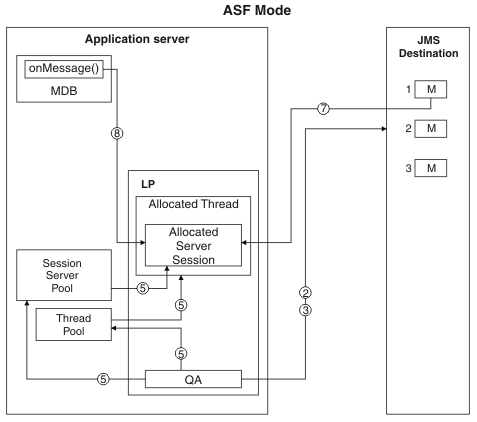WAS v8.5 > WebSphere applications > Messaging resources > Message-driven beans - automatic message retrieval > Message processing in ASF mode and non-ASF mode
How messages are processed in ASF mode
In ASF mode, server sessions and threads are only allocated for work when a message that is suitable for the MDB is detected. The number of threads that an MDB can process concurrently is determined by the value of the Maximum Sessions property for the listener port.
For WebSphere Application Server v7 and later, listener ports are stabilized. For more information, read the article on stabilized features. You should plan to migrate your WebSphere MQ message-driven bean deployment configurations from using listener ports to using activation specifications. However, you should not begin this migration until you are sure the application does not have to work on application servers earlier than WAS v7. For example, if we have an application server cluster with some members at v6.1 and some at a later version, you should not migrate applications on that cluster to use activation specifications until after you migrate all the application servers in the cluster to the later version.
The following diagram shows how messaging takes place between WAS and WebSphere MQ when the message listener service is operating in ASF mode.
Figure 1. Message processing in ASF mode on distributed and IBM i systems

As shown in the diagram, when the message listener service is operating in ASF mode, messages are processed in the following way:
- When the listener port is started, it opens a connection to the WebSphere MQ queue manager and creates an internal queue agent.
- The queue agent listens to the JMS destination for messages.
- The queue agent detects a message.
- The queue agent checks whether the message is suitable for the MDB that is using the listener port.
- If the message is suitable for the MDB, the listener port allocates a thread from the message listener service thread pool, and allocates a server session from the application server's server session pool. If this is the first time the server session has been used since the listener port has been started, it opens a connection to the JMS provider. The allocated server session runs on the allocated thread.
- The queue agent passes the ID of the message to the server session. It then starts listening for messages again.
- The server session uses the message ID to retrieve the message from the destination.
- The server session processes the message by calling the onMessage() method of the MDB.
- When the message has been processed, the server session exits and returns to the application server session pool. The connection the server session opened to the JMS provider remains open so the server session does not need to re-establish the connection the next time it is used.
- The thread exits and returns to the message listener service thread pool.
The number of threads that an MDB can process concurrently is determined by the value of the Maximum Sessions property for the listener port. If you set Maximum Sessions to the default value of 1, this means the MDB can only process one message at a time. If the queue agent finds a second message before the first message has finished being processed, the queue agent blocks the second message until processing of the first message is complete and the server session has become available.
To process more than one message concurrently, we can do this in ASF mode by setting Maximum Sessions to a value higher than 1. For example, if you set Maximum Sessions to 2, messages are processed in the following way:
- The queue agent detects the first message and allocates a thread and a server session as in the first example. The message is processed using the onMessage() method of the MDB.
- Whilst the first message is processing, the queue agent starts listening for messages again.
- The queue agent detects the second message and allocates a second
thread and a second server session. The message is processed using the onMessage() method of the MDB.
- When the first message is processed, the first server session exits and returns to the server session pool. The first thread exits
and returns to the thread pool.
- When the second message is processed, the second server session exits and returns to the server session pool. The second thread exits and returns to the thread pool.
Related concepts:
Strict message ordering using activation specifications or ASF listener ports connected to WebSphere MQ v6.0
Strict message ordering using activation specifications or ASF listener ports connected to WebSphere MQ v7.x
Reference:
Message listener service custom properties
WebSphere MQ messaging provider connection factory settings
WebSphere MQ messaging provider queue connection factory settings
WebSphere MQ messaging provider topic connection factory settings
Listener port settings
Stabilized features